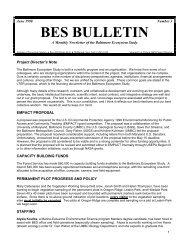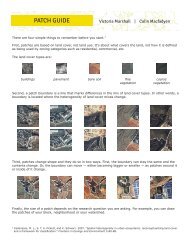Investigations in Urban Soils - Baltimore Ecosystem Study
Investigations in Urban Soils - Baltimore Ecosystem Study
Investigations in Urban Soils - Baltimore Ecosystem Study
Create successful ePaper yourself
Turn your PDF publications into a flip-book with our unique Google optimized e-Paper software.
Draft 2 - (9.28.04)<br />
<strong>Soils</strong> <strong>Urban</strong> <strong>in</strong> <strong>Investigations</strong><br />
<strong>Investigations</strong> <strong>in</strong> <strong>Urban</strong> <strong>Soils</strong>: Earthworm Populations<br />
Activities<br />
Part 1 - Background<br />
Day 1: Introduction to Investigation<br />
Students read and discuss a scientist’s <strong>in</strong>vitation to study earthworm populations <strong>in</strong> different<br />
habitats. They discuss the importance of soil and choose an <strong>in</strong>vestigation site <strong>in</strong> their<br />
community.<br />
Materials:<br />
<strong>in</strong>vitation letter from scientist (see Handout #1)<br />
background read<strong>in</strong>g or story about soil<br />
map (see Figure 15) of community with<strong>in</strong> walk<strong>in</strong>g distance of school; vegetated<br />
areas colored<br />
photos and soil samples from sites (optional)<br />
Preparation:<br />
1. Contact the soil scientist <strong>in</strong> advance to update and sign the letter or write a new<br />
one. Schedule a visit if possible.<br />
2. Scout out the nearby vegetated sites – parks, fields, even a safe median will do.<br />
Try to choose a site with a variety of habitats. Dig around for earthworms to<br />
make sure your students will get someth<strong>in</strong>g dur<strong>in</strong>g their <strong>in</strong>vestigations. It is very<br />
discourag<strong>in</strong>g for students to keep pour<strong>in</strong>g the mustard solution <strong>in</strong>to the soil with<br />
noth<strong>in</strong>g com<strong>in</strong>g out. Students will lose enthusiasm quickly.<br />
3. Ga<strong>in</strong> permission from the owner or <strong>in</strong>stitution prior to sampl<strong>in</strong>g.<br />
4. Take photos of various habitats (shrubs, mulch, grass etc) at each site and<br />
gather soil samples if possible. Divide samples <strong>in</strong>to clear plastic baggies and<br />
attach to photos. Make one set for each student pair.<br />
5. F<strong>in</strong>d and enlarge a local map or make many small copies. Make sure ideal<br />
(vegetated) sites are coded with color or texture so students know what areas<br />
they may consider. Give each site a name if it does not have one.<br />
6. To get better data and to cover more area <strong>in</strong> the community, consider team<strong>in</strong>g up<br />
with another teacher of the same grade. Each class can go to a different site to<br />
sample for earthworms. Dur<strong>in</strong>g the project and at the end, the classes can<br />
practice communicat<strong>in</strong>g their ideas and f<strong>in</strong>d<strong>in</strong>gs.<br />
Procedure:<br />
1. Ask students if they have ever done a science <strong>in</strong>vestigation, met a scientist, or<br />
felt like a scientist. This will give you an idea of the students’ backgrounds and<br />
level of enthusiasm.<br />
page 26 <strong>Baltimore</strong> <strong>Ecosystem</strong> <strong>Study</strong><br />
– <strong>Investigations</strong> <strong>in</strong> <strong>Urban</strong> <strong>Soils</strong>






